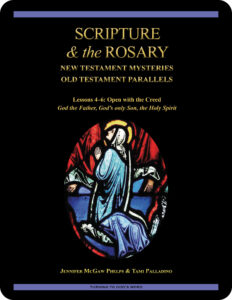 Scripture & the Rosary:
Scripture & the Rosary:
New Testament Mysteries,
Old Testament Parallels
The Creed
Lesson 4 God the Father: Creation & Faith
the book of Genesis 1:26–31
the book of Genesis 18:2–5
the book of Genesis 18:8–10
Revised Standard Version Catholic Edition (RSVCE)*
New American Bible Revised Edition (NABRE)*
Catechism of the Catholic Church
Rosarium Virginis Mariae (Rosary of the Virgin Mary)
ex libris (in our library)
Fides et Ratio (Faith and Reason)
cross references for Scripture & the Rosary
glossary for Scripture & the Rosary
next lesson: God’s Only Son: Redemption & Hope
This material coordinates with Lesson 4 on pages 12–15 in Scripture & the Rosary: New Testament Mysteries, Old Testament Parallels.
And Mary said, “My soul magnifies the Lord, and my spirit rejoices in God my Savior,
for he has regarded the low estate of his handmaiden.
For behold, henceforth all generations will call me blessed;
for he who is mighty has done great things for me, and holy is his name.”
—the Gospel According to Luke 1:46–49
welcome to our in-depth study of Scripture & the Rosary
We invite groups and individuals to become acquainted with Turning to God’s Word Catholic Bible  studies through
studies through  Scripture & the Rosary: New Testament Mysteries, Old Testament Parallels, which has been granted an imprimatur. Although no longer available in print, the first six lessons can be downloaded from our website. The remaining 20 lessons are posted throughout the liturgical year along with their related online study pages. Click here to access Lesson 4 through Lesson 6. If you have a Bible-related question or comment, you can use one of the “ask us your question” or “what do you think” buttons on any online study page to contact our authors.
Scripture & the Rosary: New Testament Mysteries, Old Testament Parallels, which has been granted an imprimatur. Although no longer available in print, the first six lessons can be downloaded from our website. The remaining 20 lessons are posted throughout the liturgical year along with their related online study pages. Click here to access Lesson 4 through Lesson 6. If you have a Bible-related question or comment, you can use one of the “ask us your question” or “what do you think” buttons on any online study page to contact our authors.
open with prayer
It’s always wise to begin any Bible study with prayer, whether reading the Scriptures alone or meeting with others in a discussion group. You can pray using your own words or use one of the opening prayers on our website. We especially like the following:
Lord Jesus, you promised to send your Holy Spirit to teach us all things.
As we read and study your word today,
allow it to touch our hearts and change our lives. Amen.
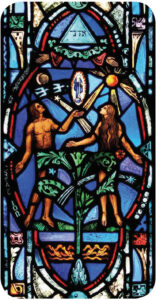 the Creed is a prayer
the Creed is a prayer
Lesson 4 begins the section in Scripture & the Rosary: New Testament Mysteries, Old Testament Parallels that examines the Apostles’ Creed, which traditionally is prayed at the beginning of the Rosary. The title of the lesson is “God the Father: Creation & Faith.” A diagram and guide to praying the Rosary can be found on this website under how to pray the Rosary.
The Creed is Trinitarian in nature. Lesson 4 through Lesson 6 look at God the Father, Christ the Son, and the Holy Spirit. Two sets of parallel themes focus on the Creed. The first is Creation, Redemption, and Sanctification; the second looks at the theological virtues of faith, hope, and love. These lessons rely heavily on material in the book of Genesis to explain the Old Testament connections that establish the foundation of our faith.
making connections between the new & the old
In Lesson 4 in Scripture & the Rosary: New Testament Mysteries, Old Testament Parallels, the connection between the Old and the New Testaments is especially obvious. The biblical text for the Creation is taken from the book of Genesis, as is the 
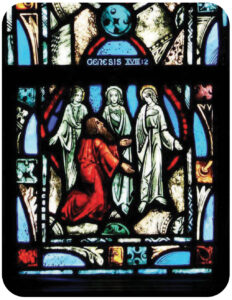 biblical text for the Old Testament parallel that looks at Abraham as the father of our faith. This is the only lesson in Scripture & the Rosary: New Testament Mysteries, Old Testament Parallels in which both biblical texts are taken from the Old Testament. Every other lesson looks at parallels between the Old and New Testaments.
biblical text for the Old Testament parallel that looks at Abraham as the father of our faith. This is the only lesson in Scripture & the Rosary: New Testament Mysteries, Old Testament Parallels in which both biblical texts are taken from the Old Testament. Every other lesson looks at parallels between the Old and New Testaments.
This makes sense. The foundation of our faith rests on our understanding of God. In establishing who God is, we need to consider the most compelling evidence we have about the nature of God. The first thing we know about God is that he’s responsible for Creation. After that, our faith is built on the covenant relationship God established with humanity. Clicking on the New and Old Testament stained glass window art will enlarge it. The same art also  illustrates Lesson 4 in Scripture & the Rosary: New Testament Mysteries, Old Testament Parallels. Our in-depth Catholic Bible study In the Beginning: The Book of Genesis looks at the lives of the patriarchs as well as at both accounts of Creation.
illustrates Lesson 4 in Scripture & the Rosary: New Testament Mysteries, Old Testament Parallels. Our in-depth Catholic Bible study In the Beginning: The Book of Genesis looks at the lives of the patriarchs as well as at both accounts of Creation.
start by reading both biblical texts
One of the most effective ways to approach the parallel themes in this study is by reading the two biblical texts that accompany each lesson before beginning to consider the questions. This helps to maintain a focus on similarities and differences between the passages. If you’re studying Scripture & the Rosary: New Testament Mysteries, Old Testament Parallels with a group, it’s beneficial to read both biblical texts aloud to set the context before beginning to discuss the questions. This refreshes everyone’s memory about what the Scripture passages say. If someone new is joining your group, or if you have any members who were unable to prepare in advance, reading the texts aloud ensures that everyone is familiar with the material and can follow the discussion.
supplemental Scripture
Not everyone is acquainted with the Old Testament parallels in Scripture & the Rosary: New Testament Mysteries, Old Testament Parallels. Additional sections of the Bible can provide more  background about what’s happening in the Old Testament text that accompanies each lesson. Reading extra Scripture is optional. Both Creation accounts and the account of the Fall of humanity (all found in the book of Genesis 1:1—3:24) provide helpful background for this lesson. More details about Abraham’s life can be found in the book of Genesis 12:1—22:19 and in Lesson 8 The Call of Abram through Lesson 13 God Tests Abraham in the Turning to God’s Word Catholic Bible study In the Beginning: The Book of Genesis.
background about what’s happening in the Old Testament text that accompanies each lesson. Reading extra Scripture is optional. Both Creation accounts and the account of the Fall of humanity (all found in the book of Genesis 1:1—3:24) provide helpful background for this lesson. More details about Abraham’s life can be found in the book of Genesis 12:1—22:19 and in Lesson 8 The Call of Abram through Lesson 13 God Tests Abraham in the Turning to God’s Word Catholic Bible study In the Beginning: The Book of Genesis.
the spiritual life is a journey
It’s no surprise that the Apostles’ Creed begins with a profession of faith in God the Father, Creator of heaven and earth. This is a natural starting point. Any discussion of Creation almost immediately leads to reflection on the Fall of Adam and Eve and to the consideration of original sin. It’s critical to understand original sin before we can begin to understand the role that Jesus Christ plays in overcoming its deadly consequences for humanity. Without a solid grasp of why we need salvation, Jesus Christ is meaningless to us, and praying the Rosary Mysteries will make no sense.
read the Catechism—about the idea of a perfect world
One of the most fascinating ideas in Lesson 4 is reinforced in paragraph 302 in the Catechism of the Catholic Church, which addresses the erroneous perception that the world was perfect at the time of Creation. According to Church teaching, the world and everything in it was created by God “in a state of journeying” toward ultimate perfection. The world wasn’t yet perfect.
 302 Creation has its own goodness and proper perfection, but it did not spring forth complete from the hands of the Creator. The universe was created “in a state of journeying” (in statu viae) toward an ultimate perfection yet to be attained, to which God has destined it. We call “divine providence” the dispositions by which God guides his creation toward this perfection:
302 Creation has its own goodness and proper perfection, but it did not spring forth complete from the hands of the Creator. The universe was created “in a state of journeying” (in statu viae) toward an ultimate perfection yet to be attained, to which God has destined it. We call “divine providence” the dispositions by which God guides his creation toward this perfection:
By his providence God protects and governs all things which he has made, “reaching mightily from one end of the earth to the other, and ordering all things well.” For “all are open and laid bare to his eyes,” even those things which are yet to come into existence through the free action of creatures.
? How many ways can you think of in which the idea of a journey figures prominently in the Scriptures?
 ? How would you map the spiritual journey of your own life so far?
? How would you map the spiritual journey of your own life so far?
? What direction do you seem to be heading?
? How would you describe your final destination?
? What can help you to get there?
? Explain how you relate to the idea of God as your Creator.
? For what purpose do you think that God created you?
? What might God pronounce “very good” when looking at you?
ex libris—find out what’s behind all those Marian feasts
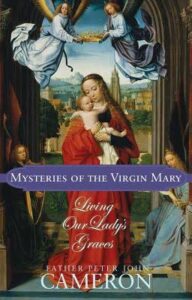 Mysteries of the Virgin Mary approaches the task of increasing understanding of the theology behind Marian doctrine by looking at reasons behind Marian
Mysteries of the Virgin Mary approaches the task of increasing understanding of the theology behind Marian doctrine by looking at reasons behind Marian  feasts throughout the liturgical year. Chapters cover the Birth of Mary, her Presentation, her Immaculate Heart, her Holy Name, and her role as Queen of Heaven, as well as her titles as Our Lady of Sorrows, Our Lady of Guadalupe, and, of course, Our Lady of the Rosary. Read excerpts and learn more about Mysteries of the Virgin Mary and other works related to Bible study at ex libris—main bookshelf.
feasts throughout the liturgical year. Chapters cover the Birth of Mary, her Presentation, her Immaculate Heart, her Holy Name, and her role as Queen of Heaven, as well as her titles as Our Lady of Sorrows, Our Lady of Guadalupe, and, of course, Our Lady of the Rosary. Read excerpts and learn more about Mysteries of the Virgin Mary and other works related to Bible study at ex libris—main bookshelf.
 Trinity—you could look it up in our archives
Trinity—you could look it up in our archives
The nature of God is a legitimate Christian mystery, but the word Trinity never appears in the Bible. To learn the meaning of the word Trinity and its Latin roots, read Lost in Translation, an online column in which Turning to God’s Word author Matthew Phelps helps readers connect with ideas expressed in the original languages of the Scriptures. New Lost in Translation entries are posted on Mondays, and past entries are archived on our website. Contact us if you’d like to receive Lost in Translation by email every week.
read the Catechism—more about the nature of the Trinity
We’re all in favor of political correctness and inclusiveness when dealing with earthly things but not when it comes to rewriting the Bible or changing the way that the Church refers to the Trinity. These three Creed lessons take the Father, Son, and Holy Spirit as their starting point, but there are legitimate parallels with Creation, Redemption, and Sanctification as well as with faith, hope, and love. Although God certainly is Creator, Redeemer, and Sanctifier, we generally avoid using those terms as primary  identifiers of the persons of the Trinity. When determining whether a Baptism performed outside the Church is sacramental, a primary distinction the Church uses has to do with language. “Father, Son, and Holy Spirit” is valid; “Creator, Redeemer, and Sanctifier” isn’t.
identifiers of the persons of the Trinity. When determining whether a Baptism performed outside the Church is sacramental, a primary distinction the Church uses has to do with language. “Father, Son, and Holy Spirit” is valid; “Creator, Redeemer, and Sanctifier” isn’t.
Baptism is such an important sacrament that the Church has ruled that in case of necessity anyone may perform it, even a non-baptized person. Paragraph 1256 in the Catechism of the Catholic Church explains.
1256 The ordinary ministers of Baptism are the bishop and priest, and, in the Latin church, also the deacon. In case of necessity, anyone, even a non-baptized person, with the required intention, can baptize, by using the Trinitarian baptismal formula. The intention required is to will to do what the Church does when she baptizes. The Church finds the reason for this possibility in the universal saving will of God and the necessity of Baptism for salvation.
Baptismal necessities
It’s essential, however, from the Church’s point of view, that two things happen: 1) the person performing the Baptism must have the intention to will to do what the Church does when performing this sacrament, and 2) the Baptism must be performed using the Trinitarian baptismal formula of Father, Son, and Holy Spirit. In the Creed, we confess one Baptism for the forgiveness of sins, so this isn’t a sacrament that should be repeated. This means that the Church must examine the previous baptismal records of any a person who enters a Rite of Christian Initiation of Adults (R.C.I.A.) program wishing to become Catholic. Most non-Catholic Baptisms are accepted by the Church as valid, but in our contemporary world some Christian denominations have changed the traditional formula for Baptism, substituting other words for “Father,” “Son,” and “Holy Spirit.” The most common substitutions, which the Catholic Church doesn’t consider valid for sacramental Baptism, substitute “Creator,” “Redeemer,” and “Sanctifier.” A priest may determine, if circumstances of previous Baptism are uncertain, to perform a conditional Baptism. This means that if a proper Baptism indeed was performed previously, it remains sacramentally valid. If not, the conditional Baptism goes into effect.
an instruction found in Scripture
It seems obvious that in insisting on the traditional Trinitarian formula, the Church is holding to the instruction given her by the risen Jesus in the Gospel According to Matthew 28:18–19: “And Jesus came and said to them, ‘All authority in heaven and on earth has been given to me. Go therefore and make disciples of all nations, baptizing them in the name of the Father and of the Son and of the Holy Spirit.'” It also seems fair to question why anyone would want to attempt to “improve” upon the baptismal formula given to us by Jesus. Although the word Trinity never appears in the Scriptures, the passage from the Gospel According to Matthew supports Christian understanding of one God in three persons.
let’s not ignore what we know about God
It’s not wrong to consider God to be a Creator, a Redeemer, or a Sanctifier. God is all of these things and many more—King of Kings, Lord of the Universe, Almighty, Wonderful Counselor, etc. Calling to mind as many titles as you can think of for God can be a fruitful meditation exercise. But the Church traditionally refers to the persons of the Most Holy Trinity as Father, Son, and Holy Spirit. The move toward Creator, Redeemer, and Sanctifier in some theological circles appears to be in response to a concern that the masculine nature of the three persons of the Trinity suggests that feminine nature is less perfect and less holy. Unfortunately, attempts to get around calling God Father, Son, and Holy Spirit ignore the central fact that what we know from divinely inspired Scripture is that God has revealed himself to humanity as Father, Son, and Holy Spirit. In the Bible there’s no ambiguity about the fatherhood of God, nor is there any question about whether Jesus was a man instead of a woman, and when Jesus speaks of the Holy Spirit in the Gospels, he uses masculine pronouns. Gender of God should be a non-issue, and to imply otherwise—no matter how noble our intentions—is to do God a disservice by flirting with some potentially hinky theology.
read the Catechism—what the Church teaches about God & gender
This doesn’t mean that the Church herself (note that the Church always is referred to using feminine pronouns) is advocating that God is some kind of male chauvinist and that women are second-class citizens. Paragraph 239 in the Catechism of the Catholic Church makes that abundantly clear:
 239 By calling God “Father,” the language of faith indicates two main things: that God is the first origin of everything and transcendent authority; and that he is at the same time goodness and loving care for all his children. God’s parental tenderness can also be expressed by the image of motherhood, which emphasizes God’s immanence, the intimacy between Creator and creature. The language of faith thus draws on the human experience of parents, who are in a way the first representatives of God for man. But this experience also tells us that human parents are fallible and can disfigure the face of fatherhood and motherhood. We ought therefore to recall that God transcends the human distinction between the sexes. He is neither man nor woman: he is God. He also transcends human fatherhood and motherhood, although he is their origin and standard: no one is father as God is Father.
239 By calling God “Father,” the language of faith indicates two main things: that God is the first origin of everything and transcendent authority; and that he is at the same time goodness and loving care for all his children. God’s parental tenderness can also be expressed by the image of motherhood, which emphasizes God’s immanence, the intimacy between Creator and creature. The language of faith thus draws on the human experience of parents, who are in a way the first representatives of God for man. But this experience also tells us that human parents are fallible and can disfigure the face of fatherhood and motherhood. We ought therefore to recall that God transcends the human distinction between the sexes. He is neither man nor woman: he is God. He also transcends human fatherhood and motherhood, although he is their origin and standard: no one is father as God is Father.
a symbol of the Trinity
“Sacred Tetragrammaton” on page 13 in Scripture & the Rosary: New Testament Mysteries, Old Testament Parallels provides information about a symbol for the Trinity based on the Hebrew letters that form the proper name of God. You can see the Tetragrammaton in the picture of the Creation Window on page 12 in Scripture & the Rosary: New Testament Mysteries, Old Testament Parallels.
visual meditation is a form of prayer
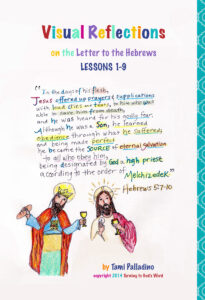 If you like to draw, consider illustrating your prayers for Scripture & the Rosary: New Testament Mysteries, Old Testament Parallels. Check out the visual-meditation journal
If you like to draw, consider illustrating your prayers for Scripture & the Rosary: New Testament Mysteries, Old Testament Parallels. Check out the visual-meditation journal  that Turning to God’s Word co-founder Tami Palladino created for The Letter to the Hebrews: An Explanation of the Mechanism of Our Salvation. Tami also illustrated Sing a New Psalm: Communicating with God Through the Prayers of the Church—Volume I: Lauds & Vespers and The Revelation of Jesus Christ: The Faithful Witness, and some lessons in You Shall Have No Other Gods: The Book of Exodus and In the Beginning: The Book of Genesis.
that Turning to God’s Word co-founder Tami Palladino created for The Letter to the Hebrews: An Explanation of the Mechanism of Our Salvation. Tami also illustrated Sing a New Psalm: Communicating with God Through the Prayers of the Church—Volume I: Lauds & Vespers and The Revelation of Jesus Christ: The Faithful Witness, and some lessons in You Shall Have No Other Gods: The Book of Exodus and In the Beginning: The Book of Genesis.
the best Catholic commentary about Scripture
 To find out more about how Church teaching is supported by passages in Scripture & the Rosary: New Testament Mysteries, Old Testament Parallels, check out the Index of Citations in the Catechism of the Catholic Church. Links to the primary Scripture passages in the lesson (Revised Standard Version Catholic Edition [RSVCE*]) and relevant paragraphs in the Catechism are provided here. Not every passage in the biblical text for this study is referenced in a Catechism paragraph, however.
To find out more about how Church teaching is supported by passages in Scripture & the Rosary: New Testament Mysteries, Old Testament Parallels, check out the Index of Citations in the Catechism of the Catholic Church. Links to the primary Scripture passages in the lesson (Revised Standard Version Catholic Edition [RSVCE*]) and relevant paragraphs in the Catechism are provided here. Not every passage in the biblical text for this study is referenced in a Catechism paragraph, however.
the book of Genesis 1:26—paragraphs 36, 225, 299, 343, 2501, 2809
the book of Genesis 1:26–27—paragraph 1602
the book of Genesis 1:26–28—paragraph 307
the book of Genesis 1:26–29—paragraph 2402
the book of Genesis 1:27—paragraphs 355, 383, 1604, 2331
the book of Genesis 1:28—paragraphs 372, 373, 1604, 1607, 1652, 2331, 2427
the book of Genesis 1:28–31—paragraph 2415
the book of Genesis 1:31—paragraphs 299, 1604
the book of Genesis 18:1–15—paragraphs 706, 2571
ways our glossary might prove helpful
In addition to providing extra information about geographical locations, our glossary also points out  when a person or place is mentioned in the biblical text under more than one name or more than one spelling. If you can remember a name but aren’t sure in which lesson it shows up, you can find it in the glossary, which lists every proper noun that appears in the primary biblical text in Scripture & the Rosary: New Testament Mysteries, Old Testament Parallels.
when a person or place is mentioned in the biblical text under more than one name or more than one spelling. If you can remember a name but aren’t sure in which lesson it shows up, you can find it in the glossary, which lists every proper noun that appears in the primary biblical text in Scripture & the Rosary: New Testament Mysteries, Old Testament Parallels.
to learn more, read more Scripture
When you’re having difficulty understanding a passage of Scripture, it can help to read the  cross references—but looking these up takes time. We’ve compiled the cross references from the Revised Standard Version Second Catholic Edition (RSV2CE)—the same translation that we reprint in our study books. The list can be found at the top of every online study page, and it includes links to cross references in the primary biblical texts for all of the lessons in Scripture & the Rosary: New Testament Mysteries, Old Testament Parallels.
cross references—but looking these up takes time. We’ve compiled the cross references from the Revised Standard Version Second Catholic Edition (RSV2CE)—the same translation that we reprint in our study books. The list can be found at the top of every online study page, and it includes links to cross references in the primary biblical texts for all of the lessons in Scripture & the Rosary: New Testament Mysteries, Old Testament Parallels.
don’t forget about our indexes & extra online material

 If you’re trying to locate information about a Scripture passage, you can look it up in the index at the back of the online version of this study. If you want to revisit a commentary, you can look it up by title in the topics index. If you want to learn more about another book of the Bible for which there’s a Turning to God’s Word study, you can read online commentaries and watch any accompanying videos by choosing a lesson from one of the study directories. (There are no lesson videos with Scripture & the Rosary: New Testament Mysteries, Old Testament Parallels.) Finally, if you have a question or would like to make a comment about any of our studies, you can use the “ask us your question” or “what do you think” button to email our authors.
If you’re trying to locate information about a Scripture passage, you can look it up in the index at the back of the online version of this study. If you want to revisit a commentary, you can look it up by title in the topics index. If you want to learn more about another book of the Bible for which there’s a Turning to God’s Word study, you can read online commentaries and watch any accompanying videos by choosing a lesson from one of the study directories. (There are no lesson videos with Scripture & the Rosary: New Testament Mysteries, Old Testament Parallels.) Finally, if you have a question or would like to make a comment about any of our studies, you can use the “ask us your question” or “what do you think” button to email our authors.
ex libris—Church documents & books about religious topics
Link to magisterial documents referred to in our Bible studies at ex libris—magisterial documents.  This listing includes significant recent encyclicals as well as a number of historical Church documents. Recommended books related to Scripture study can be found at ex libris—main bookshelf.
This listing includes significant recent encyclicals as well as a number of historical Church documents. Recommended books related to Scripture study can be found at ex libris—main bookshelf.
memorize a favorite Bible verse (4:46)
Turning to God’s Word co-founder Tami Palladino has created a short video about the benefits of memorizing Bible verses. Choosing a passage that you find particularly meaningful will make the task easier. There are inspiring verses in every book of the Bible, but some people in our Turning to God’s Word Catholic Bible studies like to memorize a verse from their lesson every week. For more ideas and helpful tips, check out Tami’s video, Why Memorize Scripture? It’s less than five minutes long.
wondering how to pronounce some of these words?
The following links are to readings from the New International Version (NIV) Bible. To listen, click on the audio icon above the printed text. Although not taken from the translations used in our study materials, the NIV readings provide an audio guide to pronunciation of words in this lesson’s primary biblical texts. A close online version of the translation of the Bible used in Catholic liturgy in the United States as well as an audio guide for daily Mass readings for the current month can be found on the website of the United States Conference of Catholic Bishops (USCCB).
the book of Genesis 1:26–31 (NIV)
the book of Genesis 18:2–5 (NIV)
the book of Genesis 18:8–10 (NIV)
pray the Rosary
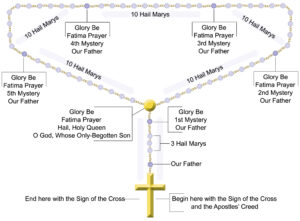 We invite you to pray the Rosary along with Turning to God’s
We invite you to pray the Rosary along with Turning to God’s  Word co-founder Tami Palladino and her daughter Anne Marie. Their videos are available on the online study pages for Lessons 7 through 26, and the Rosary prayers as well as the videos for all 20 mysteries are accessible year-round at how to pray the Rosary. Clicking on the diagram (right) will take you to the website page with the Rosary prayers. Watch Tami and Anne Marie’s how-to video (below) to learn more about praying the Rosary.
Word co-founder Tami Palladino and her daughter Anne Marie. Their videos are available on the online study pages for Lessons 7 through 26, and the Rosary prayers as well as the videos for all 20 mysteries are accessible year-round at how to pray the Rosary. Clicking on the diagram (right) will take you to the website page with the Rosary prayers. Watch Tami and Anne Marie’s how-to video (below) to learn more about praying the Rosary.
Lesson 5 God’s Only Son: Redemption & Hope—the Letter to the Hebrews 6:13–20, the book of Genesis 24:58–60 and the book of Genesis 24:62–67
Lesson 3 Assimilating the Mystery of Christ—Rosarium Virginis Mariae (chapter 3 and conclusion)
you also may like our study of the book of Genesis
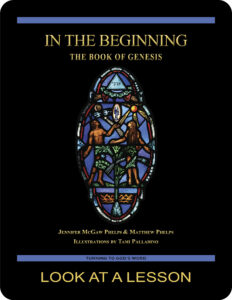 The first seven lessons of In the Beginning: The Book of Genesis, a 28-lesson Catholic Bible study with an imprimatur, provide an in-depth look at the very earliest biblical history—including the two accounts of Creation, events surrounding the Fall of Adam and Eve, the relationship between Cain and Abel, and the baptismal foreshadowing present in the account of Noah and the Flood. Remaining lessons look at lives of the patriarchs Abraham, Isaac, Jacob, and Joseph. Click on the book’s cover to view a sample lesson.
The first seven lessons of In the Beginning: The Book of Genesis, a 28-lesson Catholic Bible study with an imprimatur, provide an in-depth look at the very earliest biblical history—including the two accounts of Creation, events surrounding the Fall of Adam and Eve, the relationship between Cain and Abel, and the baptismal foreshadowing present in the account of Noah and the Flood. Remaining lessons look at lives of the patriarchs Abraham, Isaac, Jacob, and Joseph. Click on the book’s cover to view a sample lesson.
start a Turning to God’s Word Bible study
Thank you for your interest in Scripture & the Rosary: New Testament Mysteries, Old Testament Parallels. 
 Information about beginning a Turning to God’s Word Bible study can be found at start a Bible study. Tami, Matthew, and I are available to answer your questions and to offer support. You may use this email to contact us directly if you’re interested in starting a Turning to God study or in having your study schedule listed with other TtGW study groups on our website. —Jennifer
Information about beginning a Turning to God’s Word Bible study can be found at start a Bible study. Tami, Matthew, and I are available to answer your questions and to offer support. You may use this email to contact us directly if you’re interested in starting a Turning to God study or in having your study schedule listed with other TtGW study groups on our website. —Jennifer
*There are seven deuterocanonical books in the Old Testament—the Books of Tobit, Judith, Wisdom, Sirach, Baruch, and First and Second Maccabees, as well as some passages in the Books of Esther and Daniel. Protestants usually refer to these works as “apocryphal,” a word that means “outside the (Protestant) canon” because they’re excluded from most Protestant Bibles. The word “deuterocanonical” means “second canon”; Catholics use that word to refer to any section of the Catholic Old Testament for which there are no extant, or existing, Hebrew manuscripts. All of the deuterocanonical books appear in the Septuagint, the earliest remaining versions of which date to the 1st century B.C. This Greek translation of the Old Testament was in common use by Jews at the time of Jesus. Learn more by reading How Do Catholic & Protestant Bibles Differ?
Turning to God’s Word printed Bible studies use the 2006 Revised Standard Version Second Catholic Edition (RSV2CE) translation for all Scripture references except those to the Psalms, which are taken from The Abbey Psalms and Canticles, prepared by the Benedictine monks of Conception Abbey and published in 2020 by the United States Conference of Catholic Bishops (USCCB). All Scripture links for the digital version of Scripture & the Rosary: New Testament Mysteries, Old Testament Parallels are to the 1966 Revised Standard Version Catholic Edition (RSVCE) translation. The New International Version (NIV) audio recordings follow the same chapter and verse numbering as the RSV Catholic translations, but the NIV translation doesn’t include the deuterocanonical books and passages.
The 1966 RSVCE uses archaic pronouns and verb forms such as “thee,” “thou,” “didst” in the Psalms and in direct quotations attributed to God. The 2006 RSV2CE replaces these with more accessible English. The few significant translation changes in the RSV2CE include rendering almah as “virgin” in the Book of Isaiah 7:14 and restoring the term “begotten” in the Gospel According to John 3:16.
Numbering varies for some passages in this Bible study. Turning to God’s Word studies follow the numbering in the Revised Standard Version Catholic translations (RSV2CE and RSVCE). Discrepancies in the New American Bible Revised Edition (NABRE) are noted in the Index of Scripture Citations.
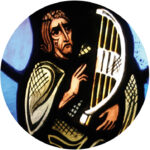 You can learn more about the Psalms by viewing a sample lesson from the Turning to God’s Word Catholic Bible study Sing a New Psalm: Communicating with God Through the Prayers of the Church—Volume I: Lauds & Vespers. The second part of that study, Sing a New Psalm: Communicating with God Through the Prayers of the Church—Volume II: Vigils, Day Prayer & Compline, is scheduled for publication in 2025. Some verse numbers may vary in different translations of the Psalms.
You can learn more about the Psalms by viewing a sample lesson from the Turning to God’s Word Catholic Bible study Sing a New Psalm: Communicating with God Through the Prayers of the Church—Volume I: Lauds & Vespers. The second part of that study, Sing a New Psalm: Communicating with God Through the Prayers of the Church—Volume II: Vigils, Day Prayer & Compline, is scheduled for publication in 2025. Some verse numbers may vary in different translations of the Psalms.
